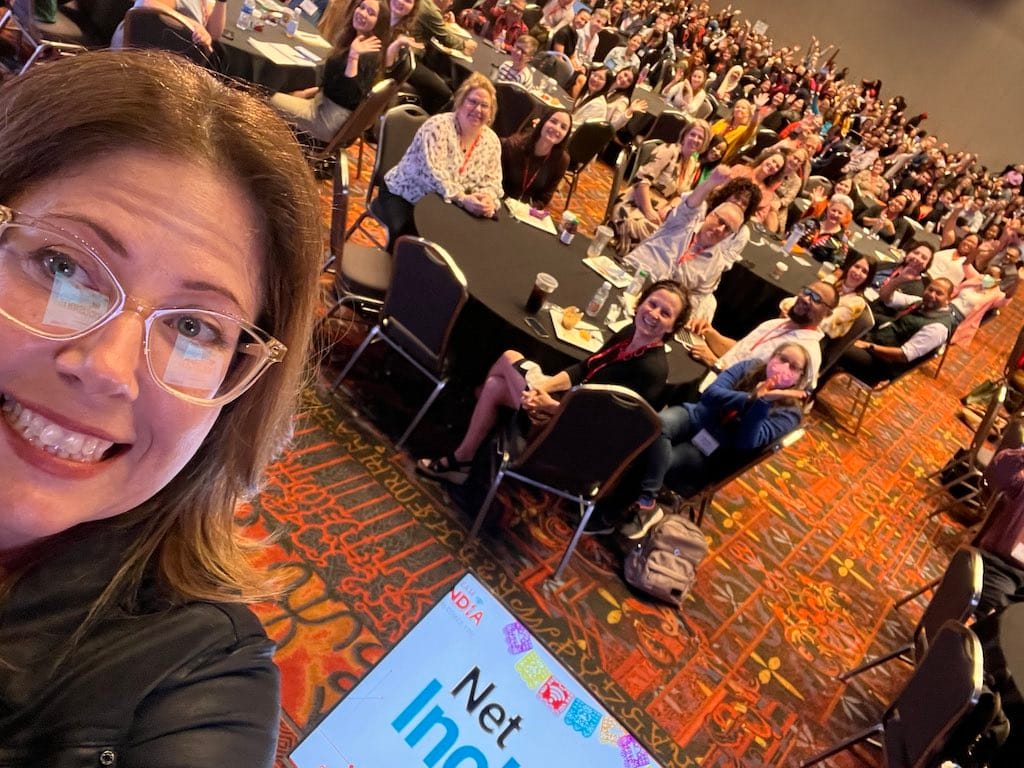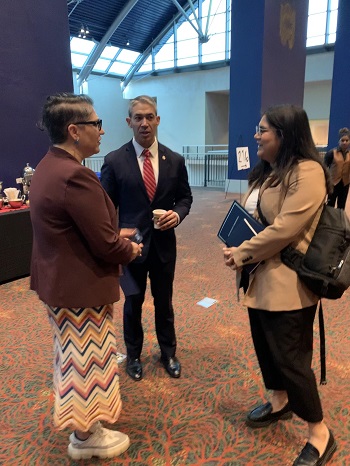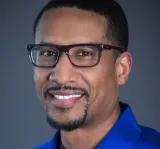Sean Gonsalves: National Digital Inclusion Alliance Hosts Largest Net Inclusion Gathering
NDIA Executive Director Angela Siefer zeroed in on the need for good data.
Sean Gonsalves

With nearly 1,000 in attendance at the Henry B. Gonzalez Convention Center in downtown San Antonio for the National Digital Inclusion Alliance (NDIA) marquee gathering, those on the front lines of bridging the digital divide across the nation came to the three-day conference (Feb 28 to March 2) to network, share lessons, best-practices, and learn from experts as the largest ever federal investment in expanding broadband access is heading to state broadband offices this summer.
Mayor addresses attendees, acknowledges open secret of segregation
San Antonio Mayor Ron Nirenberg welcomed attendees, noting how his city was a fitting venue for the event.
“It’s no secret San Antonio is one of the most socio-economically segregated cities in the United States,” he said. “And that’s why we have zeroed-in on equity – in our budget, in who gets invited to the table.”

Nirenberg congratulated NDIA for its work and the attendance record set by this year’s gathering. He also singled out our own outreach coordinator and San Antonio resident DeAnne Cuellar, not only lauding her work with ILSR’s Community Broadband Networks team but for her role in bringing city officials together with Older Adults Technology Services as the city commits to connecting 100,000 older adults in the city.
(ILSR’s Community Broadband Networks team, which has long worked with NDIA participated conducted a workshop, participated in several panels discussions, and hosted a special Connect This! live stream at a social mixer at The Friendly Spot Icehouse.)
“Broadband is a basic human right and is a public utility. That’s why digital inclusion is a pillar of our recovery program,” Nirenberg said, noting how that is reflected in line items in the city’s budget.
Mayor Nirenberg also spoke candidly about injustices that had been baked-in to city and state policies in the past and, whether intentional or not, excluded vulnerable communities across the city, putting them at a socio-economic disadvantage. He said that closing the digital divide was central to correcting those injustices.
He concluded his welcoming remarks encouraging attendees to “use technology to live, learn, work and thrive.”
Texas broadband office announces new network funding opportunity
Also on hand for the conference was Greg Conte, Director of the Texas Broadband Development Office. Conte announced a Notice of Funding Opportunity for $120 million in grants for the construction of new high-speed Internet infrastructure across the Lone Star State.
As projects are funded to build new infrastructure, the state can’t assume people will automatically subscribe for Internet service, as efforts to tackle affordability and adoption are equally important undertakings.
“We want to make sure communities can get online and use it,” he said. “We ask all Texans to help in this process.”
He also briefly touched on something numerous other state broadband offices are in the process of doing: beefing up staff as each state is set to receive an historic amount of federal funds from the bipartisan infrastructure bill’s BEAD program.
Conte was a guest on our Community Broadband Bits podcast last summer in which he discussed the challenges of staffing up his office and addressing the dearth of data about precisely where broadband is and isn’t available across the state.
Engaging other sectors in the work of advocating for more ACP funding
Batting clean-up was NDIA Executive Director Angela Siefer, who first zeroed in on the need for good data that shows and measures how local digital equity programs are working, and how those efforts can be improved.

And while quality robust data is vital, she said, it is also worth thinking about who benefits from expanded broadband access (beyond individual end-users) and how data and stories about digital inclusion initiatives can be used to engage industries and sectors of society who may not see bridging the digital divide as an urgent concern.
That includes the necessity of getting more than just Internet service providers at the table. Buy-in from healthcare providers, educational leaders, captains of retail and commerce, as well as transportation planners and housing officials should be engaged in helping to make broadband available especially for residents who struggle with affordability.
Specifically as it relates to commerce, Siefer noted, “the savings that can come from conducting certain business online can be invested into access.”
Siefer also emphasized the value of digital equity advocates sharing the stories they encounter of the lives impacted by their work with those who may not be tuned into the connectivity crisis that still plagues even such a technologically-sophisticated nation as the U.S.
Lastly, Siefer reminded the attendees that the federal funding that supports the Affordable Connectivity Program will run in the next year or so without additional appropriation from Congress.
“We need more money for the ACP,” she said, adding that it was important for state and local leaders to be pushing their Congressional representatives to replenish the ACP’s coffers.
“The long term plan is that the Universal Service Fund needs to be fixed but that is going to take time. The ACP will run out of funds before the USF is fixed,” she said.
Before the general assembly dispersed to a variety of focused workshops and breakout groups, Siefer ended with a note of encouragement: “Remember you guys are the heroes. You do the work on the ground. But NDIA has your back.”
Watch the plenary sessions below. Also, stay tuned for our new podcast series Building for Digital Equity, which will debut soon and feature interviews with dozens of frontline digital inclusion practitioners discussing the work they are doing in their local communities.
This article originally appeared on the Institute for Local Self Reliance’s Community Broadband Networks project on March 2, 2023, and is reprinted with permission.










Member discussion